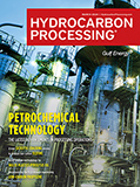Loss Prevention
The importance of operational readiness
Over the last 20 yr–30 yr, manufacturing facilities and project teams have spent significant time and money developing tools to navigate the issues of designing, procuring and building projects.
Flooded condenser vents for pressure control
Of the condensers in process industries such as refineries and petrochemical facilities, many are flooded-type condensers.
The process control journey: Primary process control—Part 1
When addressing process controls, the immediate interest is to invest in advanced process control (APC) technology without knowing the performance and stability of complex wide primary (PID) control.
Take the anxiety out of plant turnarounds
The months leading into an impending turnaround (TAR) have never been an easy time for operations and maintenance personnel.
Digital Technologies: A sustainable approach for digitalizing the petrochemical industry
In the petrochemical industry, business leaders are continuing to push for new approaches to optimize technology applications without disrupting their operational targets and key performance indicators.
Digital Exclusive: Refineries’ pandemic turmoil—KNPC’s gasoline demand: Opportunities and challenges
In this exclusive digital article, KNPC provides a comprehensive analysis of the difficulties and challenges that the company experienced during the COVID-19 epidemic and how its refineries adapted during this challenging time.
Honeywell's path to decarbonization: Leak detection, energy efficiency and asset optimization
Reducing emissions is a significant challenge several industries face, with multiple pathways being taken to increase sustainability. At Honeywell Users Group 2023, Ravi Srinivasan delivered a presentation titled “Overcoming emission challenges: The path to net zero.” Srinivasan highlighted several avenues for reducing emissions, such as proactive leak detection and remediation, energy efficiency solutions, hydrogen (H2), carbon capture, renewable fuels and offsets.
A cloud-based solution for development systems
Companies with development systems struggle with the resources to keep them up to date. It is a challenge to keep tabs on data accurately reflecting daily operations. Typically, time is lost by spending weeks analyzing differences and keeping development systems current.
Defossilizing the FCCU via co-processing of biogenic feedstock: From laboratory to commercial scale
Oil demand is expected to reach record highs this year1 after a sharp rebound following the COVID-19 pandemic.
Direction of cost-effective carbon capture and storage technologies
Around the world, many nations and companies are transitioning toward the decarbonization of energy.

- Lummus and Braskem to partner on electrified cracking heater for decarbonization 4/16
- Boeing secures its biggest purchase of Neste MY Sustainable Aviation Fuel through EPIC Fuels and Avfuel 4/16
- UAE's Fujairah March marine bunker sales hit highest in more than a year 4/16
- Eni to sell stakes in biofuel, bioplastic units by end of 2024 4/16
- Singapore aims for over 1 MMt of low-carbon methanol bunker supply by 2030 4/16
- China refiners imported record amounts of crude oil in 2023 4/16




